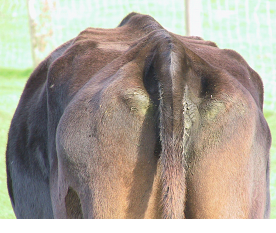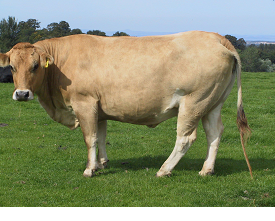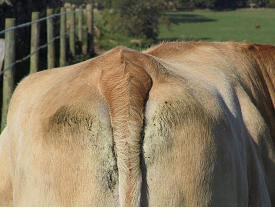Body condition (adult cattle only)
Why is it measured?
Body condition scoring is a technique for assessing the body fat reserves of livestock at regular intervals. The purpose of condition scoring is to achieve a balance between economic feeding, good production and welfare. Body condition will vary during a healthy cow’s lactation. She will most likely be at her thinnest around peak milk yield and at her fattest around drying off. However, despite this variation, her condition should not fall to score 2 or below or rise to 4 or above.
A cow with a body condition score of 1 or 2 is excessively thin and is not meeting the nutritional demands of her body. This may be as a result of feed quality/quantity, access to feed or disease. Thin animals may suffer from chronic hunger, discomfort, are predisposed to health issues (metabolic, infectious and physical), and are more likely to have reduced fertility and poor growing calves. Cows with a body condition score of 4 or more are overweight. Fat cows are at risk of dystocia (difficult calvings), more likely to develop metabolic diseases, and are prone to lameness and infertility.
How to assess and score using the AssureWel measure
3a. Body condition (adult cattle only) Individual measure
|
Sample: 20 adult animals selected at random (3 or more assessed jointly with stockperson) plus all breeding bulls
Visually assess the tail head and loin area of cattle based on the Defra condition scoring method, viewing the animal from behind and from the side. Manual assessment can help distinguish borderline scores but is not expected.
|
Scoring:
Thin = Defra score 1 or 2
Tail head
- Deep cavity with no fatty tissue under skin or shallow cavity with some fat under skin but pin bones prominent
- Skin supple/fairly supple and coat condition may be rough.
Loin
- Spine prominent. Vertebra may be identified individually
- Horizontal processes can be indentified individually with either sharp or rounded ends.
The following list should assist in making a confident decision with cows in BCS 1/2:
- Horizontal processes give a prominent shelf-like appearance to the loin
- Outline of the hook bone is prominent with no or only some fat padding
- Outline of the pin bone is prominent with no or only some fat padding
- There are folds of skin in the depression between the tail head and pin bone
- Thurl is sunken and curved in.
|


|
Moderate = Defra score 2.5 to 3.5
|
|
|
Fat = Defra score 4 or 5
Tail head
- Completely filled and folds and patches of fat evident or almost buried in fatty tissue.
Loin
- Cannot see horizontal processes and the loin area, has a completely rounded appearance.
The following list should assist in making a confident decision with cows in BCS 4/5:
- Back is solid and straight
- Hook bones are rounded with obvious fat padding or bones are/may not be visible because they are buried in fat
- Pin bones are rounded with obvious fat padding or bones are/may not be visible because they are buried in fat
- Ribs are covered with a thick layer of fat
- Thurl is filled in.
Images kindly supplied by NADIS
|


|
| 3b. Caesareans and assisted calving’s Records |
Record the number of caesarean births and assisted calving’s in the previous 12 months.
Record the total number of cows calved in the previous 12 months
|
- Lameness
- Cleanliness
- Body Condition Score (adult cattle only)
- Hairloss, lesions and swellings
- Animals with respiratory signs
- Cattle needing further care
- Disbudding, dehorning and castration
- Mortality